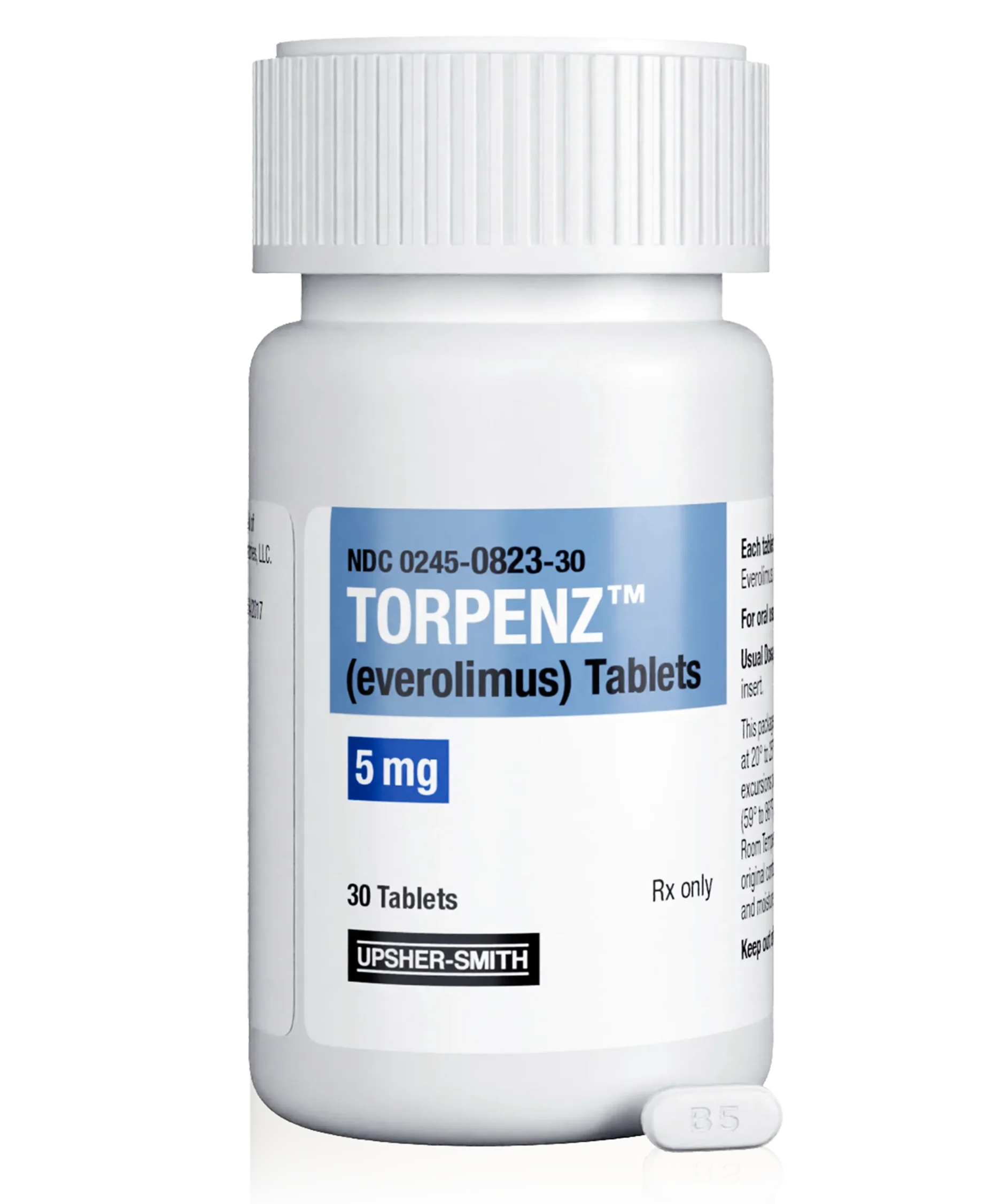
E-Prescribe through your EMR system to our specialty pharmacy partner
PANTHERx® Specialty Pharmacy
1120 Stevenson Mill Road, Suite 400
Coraopolis, PA 15108
NCPDPID: 6008002

Fax the TORPENZ™ Prescription Form:Download, print, complete, and fax the form to 1‑877‑788‑4948 (Monday-Friday 8 am-8 pm EST)
If you are sending the prescription on a weekend or after hours, fax to 1‑877‑827‑0395
We determine if the patient is:
Prescription ships to the patient from our trusted specialty pharmacy partner, PANTHERx® Rare.
Monday-Friday: 8 am-8 pm EST
Phone: 1-866-923-1954
Fax prescription forms: 1-877-788-4948
Weekends and After Hours:
Phone: 1-866-923-1954
Fax prescription forms: 1-877-827-0395
1. TORPENZ™ Tablets are a fully substitutable, AB-rated generic version of Afinitor® (everolimus) Tablets. Approved Drug Products with Therapeutic Equivalence Evaluations | Orange Book. Food and Drug Administration Web site. https://www.accessdata.fda.gov/scripts/cder/ob/index.cfm Accessed 2024. Photos on this site are of models for artistic representation and are not depicting actual patients unless otherwise noted. TORPENZ and Promise of Support are trademarks of Upsher-Smith Laboratories, LLC. All other marks are owned by their respective owners. ©2024 Upsher-Smith Laboratories, LLC, Maple Grove, MN 55369
IMPORTANT SAFETY INFORMATION for TORPENZ™ (everolimus) TABLETS for Tuberous Sclerosis Complex (TSC) Related Indications
EXPAND
Contraindications: Hypersensitivity to everolimus, to other rapamycin derivatives, or to any of the excipients.
Noninfectious Pneumonitis was reported in up to 19% of patients treated with everolimus; some cases were reported with pulmonary hypertension (including pulmonary arterial hypertension) as a secondary event. The incidence of grade 3 and 4 noninfectious pneumonitis was up to 4% and up to 0.2%, respectively. Fatal outcomes have been observed. Monitor for clinical symptoms or radiological changes. Consider opportunistic infections such as Pneumocystis jiroveci pneumonia (PJP) in the differential diagnosis. For grade 2 to 4 noninfectious pneumonitis, withhold or permanently discontinue based on severity. Corticosteroids may be indicated until clinical symptoms resolve. Administer prophylaxis for PJP when concomitant use of corticosteroids or other immunosuppressive agents are required. The development of pneumonitis has been reported even at a reduced dose.
Infections: TORPENZ has immunosuppressive properties and may predispose patients to bacterial, fungal, viral, or protozoal infections, including those with opportunistic pathogens. Localized and systemic infections, including pneumonia, mycobacterial infections, other bacterial infections; invasive fungal infections, such as aspergillosis, candidiasis, or PJP; and viral infections, including reactivation of hepatitis B virus, have occurred. Some of these infections have been severe (eg, sepsis, septic shock, or resulting in multisystem organ failure) or fatal. The incidence of grade 3 and 4 infections was up to 10% and up to 3%, respectively. Complete treatment of preexisting invasive fungal infections prior to starting treatment. Monitor for signs and symptoms of infection. Withhold or permanently discontinue TORPENZ based on severity of infection. Administer prophylaxis for PJP when concomitant use of corticosteroids or other immunosuppressive agents are required.
Severe Hypersensitivity Reactions to everolimus have been observed and include anaphylaxis, dyspnea, flushing, chest pain, and angioedema. The incidence of grade 3 hypersensitivity reactions was up to 1%. Permanently discontinue TORPENZ for the development of clinically significant hypersensitivity.
Angioedema: Patients taking concomitant ACE inhibitors with TORPENZ may be at increased risk for angioedema (eg, swelling of the airways or tongue, with or without respiratory impairment). Refer to full Prescribing Information for incidence in patients using everolimus for indications other than those related to TSC. Permanently discontinue TORPENZ for angioedema.
Stomatitis, including mouth ulcers and oral mucositis, has occurred in patients treated with everolimus at an incidence ranging from 44% to 78% across the clinical trial experience. Grade 3/4 stomatitis was reported in 4% to 9% of patients. Stomatitis most often occurs within the first 8 weeks of treatment. When starting TORPENZ, initiating dexamethasone alcohol-free oral solution as a swish-and-spit mouthwash reduces the incidence and severity of stomatitis. If stomatitis does occur, mouthwashes and/or other topical treatments are recommended, but alcohol-, hydrogen peroxide-, iodine-, or thyme-containing products should be avoided. Antifungal agents should not be used unless fungal infection has been diagnosed. Coadministration of TORPENZ and dexamethasone alcohol-free oral solution has not been studied in pediatric patients.
Renal Failure (including acute renal failure), some with a fatal outcome, have occurred in patients taking everolimus. Elevations of serum creatinine and proteinuria have been reported in patients taking everolimus. The incidence of grade 3 and 4 elevations of serum creatinine was up to 2% and up to 1%, respectively. The incidence of grade 3 and 4 proteinuria was up to 1% and up to 0.5%, respectively. Monitor renal function prior to starting TORPENZ and annually thereafter. Monitor renal function at least every 6 months in patients who have additional risk factors for renal failure.
Impaired Wound Healing: TORPENZ has the potential to adversely affect wound healing. Withhold TORPENZ for at least 1 week prior to elective surgery. Do not administer for at least 2 weeks following major surgery and until adequate wound healing occurs. The safety of resuming treatment upon resolution of wound healing complications has not been established.
Geriatric Patients: Refer to full Prescribing Information for information about geriatric patients using everolimus for indications other than those related to TSC. Careful monitoring and appropriate dose adjustments for adverse reactions are recommended.
Metabolic Disorders: Hyperglycemia, hypercholesterolemia, and hypertriglyceridemia have been reported in patients taking everolimus at an incidence up to 75%, 86%, and 73%, respectively. The incidence of these grade 3 and 4 laboratory abnormalities was up to 15% and up to 0.4%, respectively. In nondiabetic patients, monitor fasting serum glucose prior to starting TORPENZ and annually thereafter. In diabetic patients, monitor fasting serum glucose more frequently as clinically indicated. Monitor lipid profile prior to starting TORPENZ and once yearly thereafter. When possible, achieve optimal glucose and lipid control prior to starting TORPENZ. For grade 3 to 4 metabolic events, withhold or permanently discontinue TORPENZ based on severity.
Myelosuppression: Anemia, lymphopenia, neutropenia, and thrombocytopenia have been reported in patients taking everolimus. The incidence of these grade 3 and 4 laboratory abnormalities was up to 16% and up to 2%, respectively. Monitor complete blood count prior to starting TORPENZ, every 6 months for the first year of treatment, and annually thereafter. Withhold or permanently discontinue TORPENZ based on severity.
For patients with SEGA and mild or moderate hepatic impairment, adjust the dose of TORPENZ based on therapeutic drug monitoring. For patients with SEGA and severe hepatic impairment, reduce the starting dose of TORPENZ by approximately 50% and adjust subsequent doses based on therapeutic drug monitoring.
Infection or Reduced Immune Response with Vaccinations: The safety of immunization with live vaccines during everolimus therapy has not been studied. Due to the potential increased risk of infection, avoid the use of live vaccines and close contact with individuals who have received live vaccines during treatment with TORPENZ.
Radiation sensitization and radiation recall, in some cases severe, involving cutaneous and visceral organs (including radiation esophagitis and pneumonitis) have been reported in patients treated with radiation before, during, or after everolimus treatment. Monitor patients closely when administering TORPENZ during, or sequentially with, radiation treatment.
Fetal harm can occur if TORPENZ is administered to a pregnant woman. Advise pregnant women of the potential risk to a fetus. Advise female patients of reproductive potential to avoid becoming pregnant and to use effective contraception during treatment with TORPENZ and for 8 weeks after the last dose. Advise male patients with female partners of reproductive potential to use effective contraception during treatment with TORPENZ and for 4 weeks after the last dose.
Adverse Reactions in SEGA-TSC: The most common adverse reactions (incidence ≥30%, all grades) were stomatitis (62%) and respiratory tract infection (31%). The most common grade 3/4 adverse reactions (incidence ≥2%) were stomatitis, pyrexia, pneumonia, gastroenteritis, aggression, agitation, and amenorrhea. Updated safety information from 111 patients treated with everolimus tablets for a median duration of 47 months identified the following additional notable adverse reactions: decreased appetite (14%), hypertension (11%), urinary tract infection (9%), cellulitis (6%), abdominal pain (5%), and decreased weight (5%).
Laboratory Abnormalities in SEGA-TSC: The most common key laboratory abnormalities (incidence ≥50%, all grades) were hypercholesterolemia (81%) and elevated partial thromboplastin time (72%). The most common grade 3/4 laboratory abnormality (incidence ≥3%) was neutropenia (9%). Updated safety information from 111 patients treated with everolimus tablets for a median duration of 47 months identified the following additional key laboratory abnormalities: hyperglycemia (13%), decreased fibrinogen (8%), elevated creatinine (5%), and azoospermia (1%).
Adverse Reactions in Renal AML-TSC: The most common adverse reaction (incidence ≥30%, all grades) was stomatitis (78%). The most common grade 3/4 adverse reactions (incidence ≥2%) were stomatitis and amenorrhea. Updated safety information from 112 patients treated with everolimus tablets for a median duration of 3.9 years identified the following additional adverse reactions: urinary tract infection (31%), abdominal pain (16%), pruritus (12%), gastroenteritis (12%), myalgia (11%), and pneumonia (10%).
Laboratory Abnormalities in Renal AML-TSC: The most common laboratory abnormalities (incidence ≥50%, all grades) were hypercholesterolemia (85%), anemia (61%) and hypertriglyceridemia (52%). The most common grade 3/4 laboratory abnormality (incidence ≥3%) was hypophosphatemia (5%). Updated safety information from 112 patients treated with everolimus tablets for a median duration of 3.9 years identified the following additional key laboratory abnormalities: increased partial thromboplastin time (63%), increased prothrombin time (40%), decreased fibrinogen (38%), and proteinuria (18%).
Refer to full Prescribing Information for Adverse Reactions and Laboratory Abnormalities for non-TSC indications.
This safety information is not comprehensive. Please refer to the full Prescribing Information for TORPENZ . You can also visit TORPENZ.com, www.upsher-smith.com or call 1-888-650-3789.
You are encouraged to report suspected adverse reactions to Upsher-Smith Laboratories, LLC at 1-888-650-3789 or to the FDA by visiting www.fda.gov/medwatch.
INDICATIONS
TORPENZ (everolimus) Tablets are indicated for:
For additional information, including safety information, for non-TSC indications, see the full Prescribing Information, including Patient Information.
